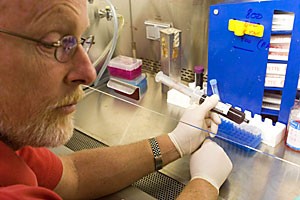Two studies presented at the annual meeting of the American Association of Blood Banks last week drew attention to the expanding importance and usefulness of umbilical cord and placental blood in treating many diseases.
The personal cord blood of four individuals was used to treat their aplastic anemia, a condition in which bone marrow no longer produces blood cells, leading to anemia, an increased risk of infection and, if untreated, death.
The cause of aplastic anemia is unknown, but the use of the cord blood seemed to cure the condition, although at this point it is too early to tell whether the fix is permanent, said David Harris, a immunology professor, scientific director and co-founder of the Cord Blood Registry, the oldest and largest such institution in the world, located in Tucson.
Harris founded the Cord Blood Registry in 1992, using the cord blood of his son as the first sample.
Now, Harris has stored the cord blood of nearly 200,000 people from 72 countries.
Despite the controversy that surrounds stem cell research, cord blood “”can help with a whole bunch of diseases,”” Harris said, citing studies that have been done involving the treatment of leukemia, diabetes, cerebral palsy, brain injuries and other conditions.
With the current ban on government funding for embryonic stem cell research, cord blood is considered one of the best resources for stem cell research.
The National Institute of Health is performing more than 200 studies on the use of cord blood in regenerative medicine, Harris said.
“”Government should stay out of science,”” he said, but even without the ban, “”using embryonic stem cells is not practical.””
It can cost $60,000 and take six months to develop the cells, Harris said.
“”It will never be as cheap as cord blood,”” he added.
In the case
Government should stay out of science.
-David T. Harris,
co-founder of the Cord Blood Registry
of aplastic anemia, traditional treatment requires replacement of bone marrow from a compatible donor, like a close relative, but “”the right bone marrow is hard to find,”” Harris said, adding that there is a risk of side effects from rejection that can lead to a patient’s death.
With cord blood, which can be stored for at least 15 years, the risk is much slimmer and is lowered even further if the blood is the patient’s own, he said.
Cord blood transplants work on the same principle as bone marrow transplants, using stem cells to replace the defective cells that are first removed using chemotherapy.
“”It works for diseases from the environment or viruses,”” Harris said.
The transplants are not effective for genetic conditions, he said, since DNA is part of the stem cells.
Recovering the blood costs $1,500, with a $100 storing fee per year.
The actual transplant is incorporated into regular transplant surgery, with nearly 100 transplants performed to date, Harris said.
“”We recover about 70 to 100 (cubic centimeters) of cord blood, around 6 to 8 ounces, or about as much as a juice glass,”” he said. “”But it has the concentration of stem cells of a quart of marrow.””
The future use of cord blood seems promising, especially in regenerative medicine.
“”There’s a one-in-three chance you’ll need it,”” whether for Parkinson’s, heart or liver disease, or stroke, Harris said.
He expects that someday cord blood will be saved and stored as much as other forms of blood today.
“”It’s more promising than we could have hoped for,”” he said.









